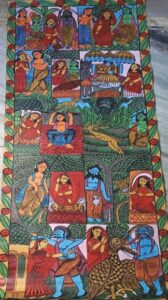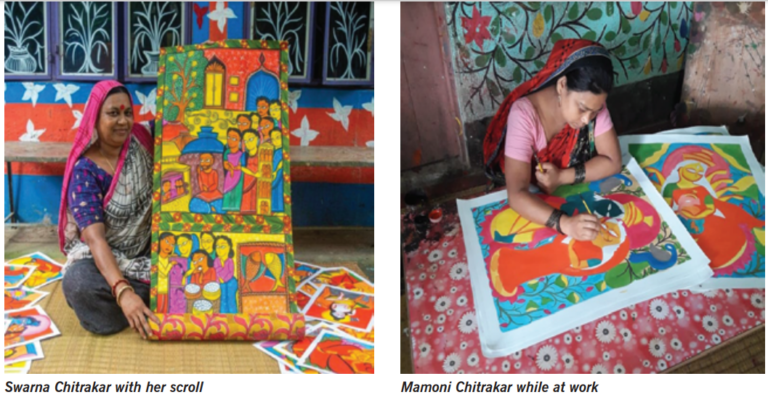The Chitrakar community of Naya village, Midnapore in West Bengal are narrative scroll painters who in the past provided edutainment to rural audiences by singing stories from mythology and social context. Hiraman tell us how this community has preserved their tradition and transformed an idyllic village with their art into a thriving tourist destination.
Swarna Chitrakar has a Wikipedia page and is a critically acclaimed traditional artist. She has visited the US and the UK multiple times, apart from France, Italy, Germany and Sweden to showcase her art skills, collaborate with artists and participate in residency programmes.
Anwar Chitrakar is a National Master Craftsmen-awardee and a reputed painter who sold his canvas at a Dubai-held auction for Rs 4 lakhs in 2021. He has showcased his work at London’s Victoria & Albert Museum and Mumbai’s Jehangir Art Gallery among several others.
Mamoni Chitrakar, married with two school-going kids is a much-admired artist and has held workshops at the US-based Smithsonian Institute and holds weekly online heritage appreciation classes from her home in a Midnapore village in West Bengal.
They all have one thing in common, their surname, Chitrakar, and the art form they pursue. The Chitrakar community resides in village Naya in Pingla block of Midnapore and are patuas— a semi-itinerant caste of narrative scroll painters who provided edutainment to rural audiences by singing stories from mythology and social context in the past but presently have transformed an idyllic village with their art into a tourist destination.

Every patua has two names, one Hindu and the other Islamic. Their diverse repertoire includes tales from Hindu mythology, tribal folklore, as well as Islamic tradition, the Patachitra in West Bengal has progressively regained its new voice to continue new conversation formats with the society at large, engaging with contemporary themes for a global audience.
Unrolling the hand-painted scroll frame by frame— props for their performance—they sang the pater gaan (story song). In places like Birbhum, Bankura, Nandigram and Chandipur this performative art is still practised by a handful of families but it is in Naya where it has flourished. Naya’s pats are diverse in their repertoire and have boldly embraced contemporary themes.
With the introduction of visual media, like TV and cinemas, the art of patuas witnessed a rapid decline. No more considered artists but treated as beggars most sought out odd jobs or migrated to urban centres in search of livelihood working as tailors, painters, vegetable sellers or worked as daily wagers.
It was in 2004 following a visit of a social enterprise which specialises in developing community-led creative industries based on cultural heritage like performing arts and crafts things began to change. Informs Siddhanjan Ray Chaudhuri, General Manager – Business Development & Projects, banglanataak.com, “During our maiden visit to Naya we found that there were 25-odd patuas who still made their living telling stories using pats painted in vegetable colours and living in mud houses. With no industries around to provide them with jobs, we planned how we could augment their livelihood by doing what they knew best. That’s painting and singing songs.”
In the last decade and a half since Banglanatak intervened it has invested in the skill enhancement among the senior patuas and skill development of the youth; brought in artists from abroad to engage the patuas to try new mediums; encouraged the cultivation of plants for dyes and colours; introduced product diversification; invited collectors, connoisseurs and scholars from India and abroad to Naya; supported participation of the patuas in art festivals, holding workshops in museums and galleries abroad; and importantly organising an annual folk art festival which draws tourists in hordes.
Presently, 250-odd artists reside in Naya who make a living through painting, be it on scrolls, canvas, coffee mugs, dress materials, furnishing and other utilitarian products. The village, an ultimate tourist attraction for those visiting West Bengal has emerged as an exemplar of folk artists’ community thriving, thanks to their art. For the Kolkattans visiting the village on weekends, Naya is like a living museum with the walls painted in vivid colours, every courtyard an art gallery and the patuas busy painting or humming songs.
“Each artist makes anything between Rs 40,000 to Rs 60,000 a month. While a few who have made their name in the art world can sell a painting worth a couple of lakhs,” says Manoranjan Chitrakar, who is in his mid-40s.
The increasing demand for patuas in the local and global economy has given rise to the growing participation of all the members of the Chitrakar community, especially women. Unlike in the past, today women travel beyond their village, and in doing so introduce newer transformations within the patua community and the art form. In present times, Patachitra has emerged as a fluid art and subjects like human trafficking, girls’ education, rural elections, rationing, tree protection, female infanticide, Tsunami, Cyclone Amphan and AIDS awareness are painted with wide abandon. During the Corona epidemic, pats were used to raise awareness and deliver crucial messages in rural Bengal and one such pat by veteran artist Swarna Chitrakar became viral garnering one lakh views.
Pingla is now a flourishing hub of more than 300 artists with its cooperative, Chitrataru Collective, which focuses on marketing better opportunities for its artists and the development of the village as a whole. “Unlike men, we get to paint only after having done the household chores. It’s a couple of hours mid-evening or post dinner that I am able to devote to painting,” says Mamoni Chitrkar, whose scroll nine feet-long scroll during the pandemic was brought by a London collector for Rs 45,000.
In order to preserve the tradition and showcase different types of patas, a Folk Art Centre has come up in the village. Since 2010, it has been organising the annual Patachitra festival- POT Maya which attracts tourists and attracts the sale of products running into lakhs. Incidentally, Chitrataru has bagged a GI tag for their art form.

